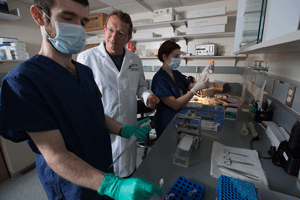Researchers block body's response to cold, open doors to new drug treatments
 As much as human beings have evolved throughout history, at least one thing hasn’t changed much – the way our bodies react to the cold. But researchers at St. Joseph’s believe they have finally discovered a way to block the body’s response to cold using an individual drug, a finding that could have significant implications in treating conditions like stroke and cardiac arrest.
As much as human beings have evolved throughout history, at least one thing hasn’t changed much – the way our bodies react to the cold. But researchers at St. Joseph’s believe they have finally discovered a way to block the body’s response to cold using an individual drug, a finding that could have significant implications in treating conditions like stroke and cardiac arrest.
The groundbreaking research, led by Andrej Romanovsky, MD, PhD, director of the Systemic Inflammation Laboratory, or FeverLab, part of St. Joseph’s Trauma Program, was published in the Feb. 8 issue of the Journal of Neuroscience and was also highlighted in Scientific American earlier this year. The research took place at St. Joseph’s, in collaboration with Amgen Inc. and several academic institutions.
Lowering the body’s temperature is an effective way to treat certain conditions because of the body’s decreased need for energy and oxygen at low temperatures. However, natural defense mechanisms to maintain a steady temperature – such as shivering, narrowing of blood vessels in the skin and generating heat in the so-called brown fat tissue – can make it difficult to lower body temperature in unanesthetized patients.
Dr. Romanovsky, research team members Camila Almeida, PhD, and Andras Garami, MD, PhD, and collaborator Narender Gavva, PhD, believe they have discovered a pharmacological method to inhibit these natural defense mechanisms.
“Humans have used external heating and insulation as the only approaches to defend themselves against cold since the days of the caveman. We have proposed something new,” says Dr. Romanovsky. “Our study is significant because it is the first time we have been able to inactivate the body’s natural defense mechanisms by using a drug that selectively blocks the sensation of cooling in the skin.”
The research focuses on the TRPM8 (transient receptor potential melastatin-8) receptor, a protein responsible for relaying the sensation of skin cooling, and on the drug M8-B, a TRPM8 antagonist. In other words, the M8-B drug blocks the TRPM8 protein from relaying cold signals from the skin to the brain.